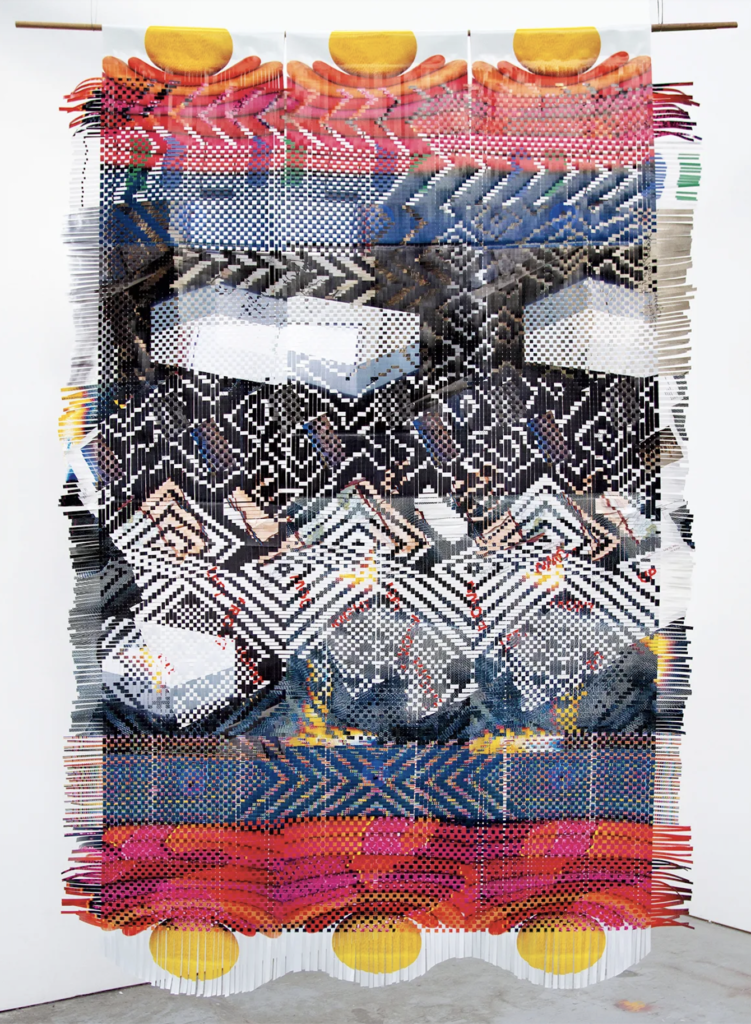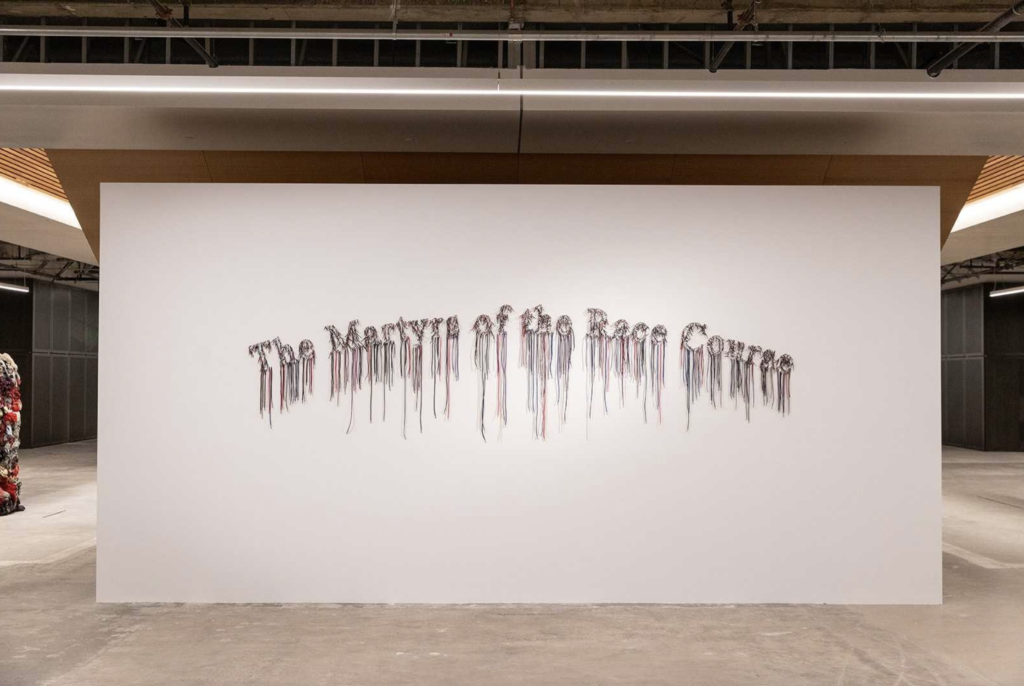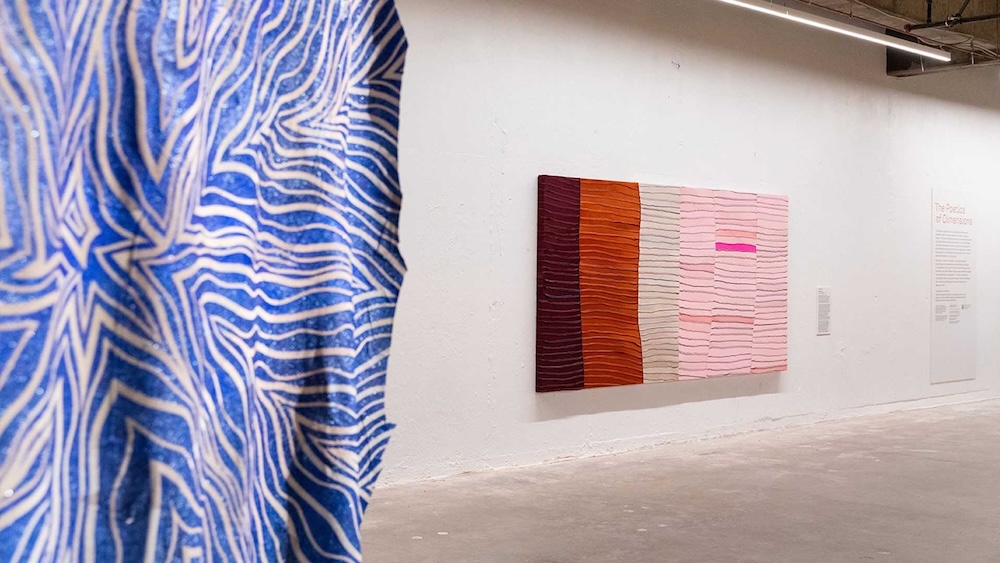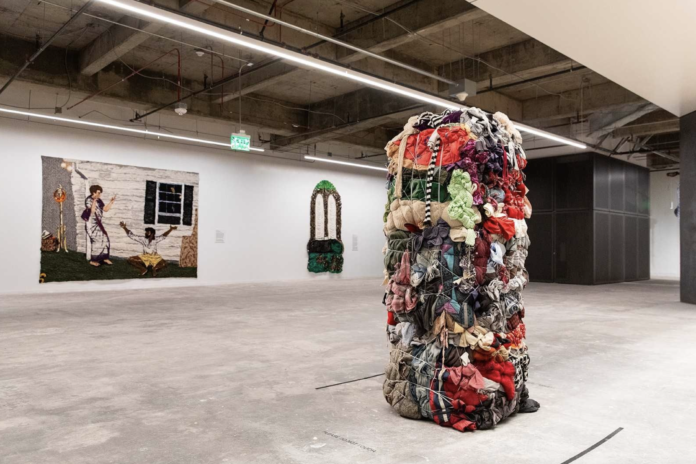In “The Poetics of Dimensions,” through March 16 at the Institute of Contemporary Art San Francisco, guest curator Larry Ossei-Mensah showcases 11 international, national, and local artists’ sculptures and two-dimensional works brimming with found objects, like brightly logo-ed bottle caps; shiny aerosol can tips; and colorful clothes, shoelaces, and durags. Underneath this excessive visual stimuli, the exhibition’s works prioritize assemblage as a transformative process, where, with varying degrees of material manipulation, the artists assert their source materials’ recognizability as a form of cultural dialogue.

Among the featured artists, Shinique Smith and Nari Ward deliver moving works that solely rely upon assembling and arranging large quantities of clothing and shoelaces, respectively, to address personal histories and the larger history of slavery in the United States. In Smith’s “Bale Variant No 0014” (2008), the artist riffs on the materiality of cotton bales by presenting a large rectangular block of clothing sourced from her own wardrobe, her grandmother’s home, and friends and family.
Recognizable clothing labels, like Levis, and mass produced silk-screened tee-shirts contextualize the clothes in the present, while ivory-colored lace garments and silk rose embellishments recall the past. The frenetic network of ropes bounding the clothes together into bales speaks to the unnamed agricultural labor exploited during slavery.
Standing taller than most viewers’ heads, Smith’s bale takes on an anthropomorphic presence, reinforced by the clothing’s bodily reference, traces of her friends and family. With the clothes haphazardly heaped and bundled together, the work’s structural instability and synergy carries the potential for personal connections and social histories to collapse, morph, or grow.

In Ward’s “The Martyrs of the Race Course” (2023), the artist threaded yards of individual shoelaces through precisely drilled holes in a blank white wall to spell out the text “The Martyrs of the Race Course.” As the laces’ rigid aglets poke out and splay in various directions, the text takes a fuzzy, out-of-focus quality. Additionally, as the linear shoelaces succumb to gravity and dangle against the wall, they create the illusion that the text is streaking from tears or rain.
While there’s almost a patriotic feel with bright red-and-white laces dotted amongst the darker-hued ones, Ward’s text memorializes a complicated episode of American history, namely Hampton Park: the Charleston, South Carolina horse racing track that the Confederate army transformed into a prisoner-of-war camp. During the Civil War, hundreds of Union soldiers died from abuse and were buried in unmarked graves at Hampton Park. After the war, emancipated slaves reburied Union soldiers and built an archway inscribed “Martyrs of the Race Course” to pay respect to the soldiers’ sacrifices.

With fresh and clean shoelaces from sneakers, dress shoes, and work boots, Ward’s installation poetically suggests the many people, from many walks of life, who have benefited from the sacrifices and injury of previous generations. While extremely banal, the ubiquity of shoelaces and their direct relation to our feet embody a collective will and our freedom of movement, leisure, and labor.
Most poignantly, Smith’s and Ward’s use of commonly recognized objects operate as stand-ins for specific individuals, communities, and historical legacies, where the embodiment of a collective whole also holds space for varieties and differences within it. Moreover, by strategically using mass-produced materials, the artists have each continued to explore the conceptual root of the work through series or iterations of bales or shoelace installations. As these works continue to unfold, Smith and Ward tap into a larger exploration of how artists create the context for potential and change.
THE POETICS OF DIMENSIONS runs through March 16. Institute of Contemporary Art San Francisco. More info here.





